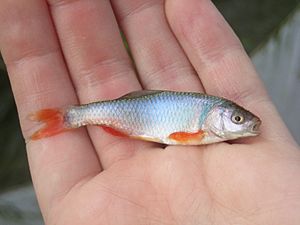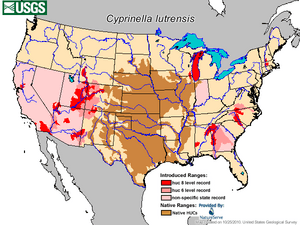Red shiner facts for kids
Quick facts for kids Red shiner |
|
|---|---|
 |
|
| Conservation status | |
| Scientific classification | |
| Synonyms | |
|
The red shiner (Cyprinella lutrensis) is a small freshwater fish found in North America. It is also sometimes called the red-horse minnow. This fish belongs to the Cyprinidae family, which includes many types of minnows.
Red shiners have a deep body and are flattened from side to side. They can grow to about three inches long. Most of the year, both male and female red shiners have shiny silver sides and white bellies. However, during breeding season, males become very colorful. Their sides turn iridescent pink, purple, or blue. Their head and fins (except the top fin) become bright red.
These fish can live for up to three years. They are omnivores, meaning they eat both plants and animals. Their diet includes small creatures that live in water or on land, as well as algae. Red shiners have also been seen eating the eggs and young fish of other species in places where they are not native.
Contents
Reproduction and Life Cycle
The red shiner's spawning season usually runs from mid-April through September. Like other fish in the Cyprinella group, they lay eggs in small cracks. They also spread their eggs and attach them to rocks and plants.
A female red shiner can lay up to 16 batches of eggs in one day. Each batch can have up to 71 eggs. On average, a female lays about 585 eggs at a time. She might have five to 19 groups of eggs in one breeding season. Red shiners can also create hybrid offspring with closely related fish. This means they can have babies with species like the blue shiner and the blacktail shiner.
Where Red Shiners Live
Red shiners naturally live in many different water environments. These include quiet backwaters, creek mouths, and streams with sand or silt bottoms. They also live in riffles (shallow, fast-moving parts of a stream) and deeper pools.
These fish can handle cloudy water and areas with a lot of silt. However, they tend to avoid water that is very acidic. Red shiners are known as "habitat generalists." This means they can adapt to many different conditions that other fish might find difficult. They can even live in places changed by humans, like polluted waterways. They can also survive in places with extreme natural conditions or where water flows only sometimes.
Where They Are Found
The red shiner is naturally found in the Mississippi River basin. This area stretches from southern Wisconsin and eastern Indiana to South Dakota and Wyoming. It also goes south to Louisiana.
Red shiners have also been introduced to many other states. These include Arizona, California, Colorado, Illinois, and Georgia. They are also found in Nebraska, North Carolina, South Carolina, Wyoming, Massachusetts, Utah, Virginia, Nevada, and New Mexico.
Even though the species is common, one type of red shiner from Maravillas Creek in Texas is now extinct. This happened in the late 1950s. It was due to competition from another fish called the plains killifish.
Why They Are a Concern
Red shiners are often used as bait fish by anglers. When people empty their bait buckets, these fish can get into new waters. This is thought to be the main way they spread to new areas. They are also sometimes kept as aquarium fish.
The red shiner has become a species of special concern in the United States. This is because it has caused problems for native fish populations where it has been introduced. As mentioned, red shiners can eat the eggs of native fish. This can stop those native fish populations from growing.
Red shiners can also thrive in many different environments. They are better at living in disturbed habitats than many native species. This gives them an advantage. They can also create hybrid fish with the blacktail shiner (Cyprinella venusta). This native species lives in the Coosa River. When they hybridize, it can weaken the gene pool of the native blacktail shiner.
See also
 In Spanish: Cyprinella lutrensis para niños
In Spanish: Cyprinella lutrensis para niños



